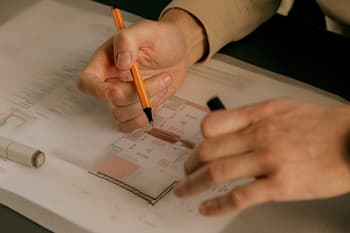The design and construct model is often used for large-scale domestic buildings, such as apartments and large commercial buildings, and infrastructure work, such as rail projects. However, a design and construction procurement method differs from a construct-only procurement method. It is integral that you know the difference between these two methods and implement them both accordingly. As a contractor, you will carry different risks under each method. This article will outline what a design and construct procurement method is and when you should be using it.
What is a Design and Construct Procurement Method?
In your role as a contractor, you will often be engaged by a principal to design and construct a project, such as an apartment complex. Under this engagement, you will likely be responsible for completing the project design and executing the physical construction. Before engaging you, the principal should have engaged design consultants to create a concept or preliminary design outlining the project’s requirements. You should then receive these initial designs from the principal.
Since you are responsible for both the design and construction aspects, you bear the risks associated with both parts.
How is This Different From a Construct-Only Procurement Method Contract?
Under a construct-only contract, the principal engages a designer or architect to create the project’s final designs. Once the design phase is complete, the principal seeks bids or proposals from various construction contractors for the construction phase.
Under this procurement method, your primary role as a contractor is to execute the construction according to the established design and specifications. You are responsible for:
- managing the construction process;
- hiring subcontractors;
- procuring materials; and
- ensuring that the project adheres to the agreed-upon schedule and quality standards.
In this situation, the risk that you carry is limited to the construction phase.
Continue reading this article below the formWhat Are My Roles and Responsibilities?
Design Phase
As the contractor, you will receive preliminary concepts and ideas from the principal. Your expertise will come into play as you transform these initial concepts into a comprehensive and detailed plan that encompasses all aspects of the project.
During the design phase, you will collaborate closely with architects, engineers, and other specialists to bring the project to life on paper. From architectural blueprints to engineering drawings, you will create a cohesive design that not only meets the project’s functional and aesthetic requirements but also ensures that it fits within the agreed-upon budget.
Construction Phase
Upon the finalisation and approval of the design by the principal, the project will then transition into the construction phase. During this phase, you will assume a leadership role, overseeing all construction activities and ensuring strict adherence to the approved design documentation. You will be responsible for ensuring that the constructed project meets the principal’s requirements as specified. From the commencement of site works to the application of finishing touches, you will manage the entire construction process, ensuring that all activities progress efficiently and in accordance with the established project plan.

Whether you’re a small business owner or the Chief Financial Officer of an ASX-listed company, one fact remains: your customers need to pay you.
This manual aims to help business owners, financial controllers and credit managers best manage and recover their debt.
What Are the Risks?
As the single point of responsibility for both design and construction, you bear the risks associated with the entire project. This means that you will be responsible for any challenges or unforeseen obstacles that may arise throughout the process.
Your expertise and careful management will be crucial in delivering a successful project and meeting the client’s expectations. As the driving force behind the design and construction, you will have the opportunity to showcase your skills, innovation, and commitment to excellence throughout the entire project lifecycle. The design and construct procurement method offers a unique opportunity to leave a lasting impact on the project, from its conceptualisation to its realisation.
Key Takeaways
The design and construct procurement method involves a contractor who is responsible for both the design and the construction of a project. This contrasts with a construct-only procurement method where the design is completed by the principal’s designer, and construction bids are sought thereafter. Under the design and construct method, you start with a preliminary design from the principal’s consultants and further develop it into a detailed ‘for construction’ design. During the design phase, you will collaborate with various specialists to formulate detailed plans that meet both functional and aesthetic requirements within the budget. In the construction phase, you will oversee all aspects of construction, ensuring adherence to the approved designs and accomplishing the principal’s specifications.
If you have encountered risks in your building project, our experienced construction lawyers can assist as part of our LegalVision membership. For a low monthly fee, you will have unlimited access to solicitors to answer your questions and draft and review your documents. Call us today on 1300 544 755 or visit our membership page.
Frequently Asked Questions
In the design phase, the contractor collaborates closely with architects, engineers, and other specialists, sharing and refining the client’s preliminary concepts. The contractor may take over the consultants previously engaged by the principal or engage other consultants to further develop the design and document it.
As the designer and builder under a design and construct procurement method, you are responsible for developing the project’s design and all risks in the design, overseeing construction, managing the budget, and ensuring quality, potential cost overruns, and meeting client expectations. Careful management and expertise are essential for successful project delivery, including ensuring that your overall liability is limited under the contract.
We appreciate your feedback – your submission has been successfully received.











